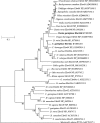Elongation of very Long-Chain (>C24) Fatty Acids in Clarias gariepinus: Cloning, Functional Characterization and Tissue Expression of elovl4 Elongases
- PMID: 28856549
- PMCID: PMC5613102
- DOI: 10.1007/s11745-017-4289-3
Elongation of very Long-Chain (>C24) Fatty Acids in Clarias gariepinus: Cloning, Functional Characterization and Tissue Expression of elovl4 Elongases
Abstract
Elongation of very long-chain fatty acid 4 (Elovl4) proteins participate in the biosynthesis of very long-chain (>C24) saturated and polyunsaturated fatty acids (FA). Previous studies have shown that fish possess two different forms of Elovl4, termed Elovl4a and Elovl4b. The present study aimed to characterize both molecularly and functionally two elovl4 cDNA from the African catfish Clarias gariepinus. The results confirmed that C. gariepinus possessed two elovl4-like elongases with high homology to two previously characterized Elovl4 from Danio rerio, and thus they were termed accordingly as Elovl4a and Elovl4b. The C. gariepinus Elovl4a and Elovl4b have open reading frames (ORF) of 945 and 915 base pairs, respectively, encoding putative proteins of 314 and 304 amino acids, respectively. Functional characterization in yeast showed both Elovl4 enzymes have activity towards all the PUFA substrates assayed (18:4n-3, 18:3n-6, 20:5n-3, 20:4n-6, 22:5n-3, 22:4n-6 and 22:6n-3), producing elongated products of up to C36. Moreover, the C. gariepinus Elovl4a and Elovl4b were able to elongate very long-chain saturated FA (VLC-SFA) as denoted by increased levels of 28:0 and longer FA in yeast transformed with elovl4 ORF compared to control yeast. These results confirmed that C. gariepinus Elovl4 play important roles in the biosynthesis of very long-chain FA. Tissue distribution analysis of elovl4 mRNAs showed both genes were widely expressed in all tissues analyzed, with high expression of elovl4a in pituitary and brain, whereas female gonad and pituitary had the highest expression levels for elovl4b.
Keywords: Biosynthesis; Clarias gariepinus; Essential fatty acids; Very long-chain fatty acids; elovl4.
Figures




Similar articles
-
Molecular and functional characterisation of two elovl4 elongases involved in the biosynthesis of very long-chain (>C24) polyunsaturated fatty acids in black seabream Acanthopagrus schlegelii.Comp Biochem Physiol B Biochem Mol Biol. 2017 Oct;212:41-50. doi: 10.1016/j.cbpb.2017.06.008. Epub 2017 Jun 29. Comp Biochem Physiol B Biochem Mol Biol. 2017. PMID: 28668330
-
The fatty acid elongation genes elovl4a and elovl4b are present and functional in the genome of tambaqui (Colossoma macropomum).Comp Biochem Physiol B Biochem Mol Biol. 2020 Jul;245:110447. doi: 10.1016/j.cbpb.2020.110447. Epub 2020 Apr 20. Comp Biochem Physiol B Biochem Mol Biol. 2020. PMID: 32325254
-
Expression and role of Elovl4 elongases in biosynthesis of very long-chain fatty acids during zebrafish Danio rerio early embryonic development.Biochim Biophys Acta. 2010 Oct;1801(10):1145-54. doi: 10.1016/j.bbalip.2010.06.005. Epub 2010 Jul 1. Biochim Biophys Acta. 2010. PMID: 20601113
-
Retinal very long-chain PUFAs: new insights from studies on ELOVL4 protein.J Lipid Res. 2010 Jul;51(7):1624-42. doi: 10.1194/jlr.R005025. Epub 2010 Mar 18. J Lipid Res. 2010. PMID: 20299492 Free PMC article. Review.
-
Very long chain fatty acid-containing lipids: a decade of novel insights from the study of ELOVL4.J Lipid Res. 2021;62:100030. doi: 10.1016/j.jlr.2021.100030. Epub 2021 Feb 6. J Lipid Res. 2021. PMID: 33556440 Free PMC article. Review.
Cited by
-
Determination of very long-chain polyunsaturated fatty acids from 24 to 44 carbons in eye, brain and gonads of wild and cultured gilthead sea bream (Sparus aurata).Sci Rep. 2022 Jun 16;12(1):10112. doi: 10.1038/s41598-022-14361-0. Sci Rep. 2022. PMID: 35710933 Free PMC article.
-
Therapeutic Role of ELOVL in Neurological Diseases.ACS Omega. 2023 Mar 8;8(11):9764-9774. doi: 10.1021/acsomega.3c00056. eCollection 2023 Mar 21. ACS Omega. 2023. PMID: 36969404 Free PMC article. Review.
-
A complete inventory of long-chain polyunsaturated fatty acid biosynthesis pathway enzymes in the miniaturized cyprinid Paedocypris micromegethes.Fish Physiol Biochem. 2022 Aug;48(4):817-838. doi: 10.1007/s10695-022-01082-4. Epub 2022 May 29. Fish Physiol Biochem. 2022. PMID: 35643977
-
Molecular and Functional Characterization of Elovl4 Genes in Sparus aurata and Solea senegalensis Pointing to a Critical Role in Very Long-Chain (>C24) Fatty Acid Synthesis during Early Neural Development of Fish.Int J Mol Sci. 2020 May 15;21(10):3514. doi: 10.3390/ijms21103514. Int J Mol Sci. 2020. PMID: 32429178 Free PMC article.
-
A chromosome-level genome assembly of the jade perch (Scortum barcoo).Sci Data. 2022 Jul 15;9(1):408. doi: 10.1038/s41597-022-01523-y. Sci Data. 2022. PMID: 35840598 Free PMC article.
References
-
- Bell MV, Tocher DR. Biosynthesis of polyunsaturated fatty acids in aquatic ecosystems: general pathways and new directions. In: Arts MT, Brett M, Kainz M, editors. Lipids in aquatic ecosystems. New York: Springer; 2009. pp. 211–236.
MeSH terms
Substances
Grants and funding
LinkOut - more resources
Full Text Sources
Other Literature Sources
Molecular Biology Databases

